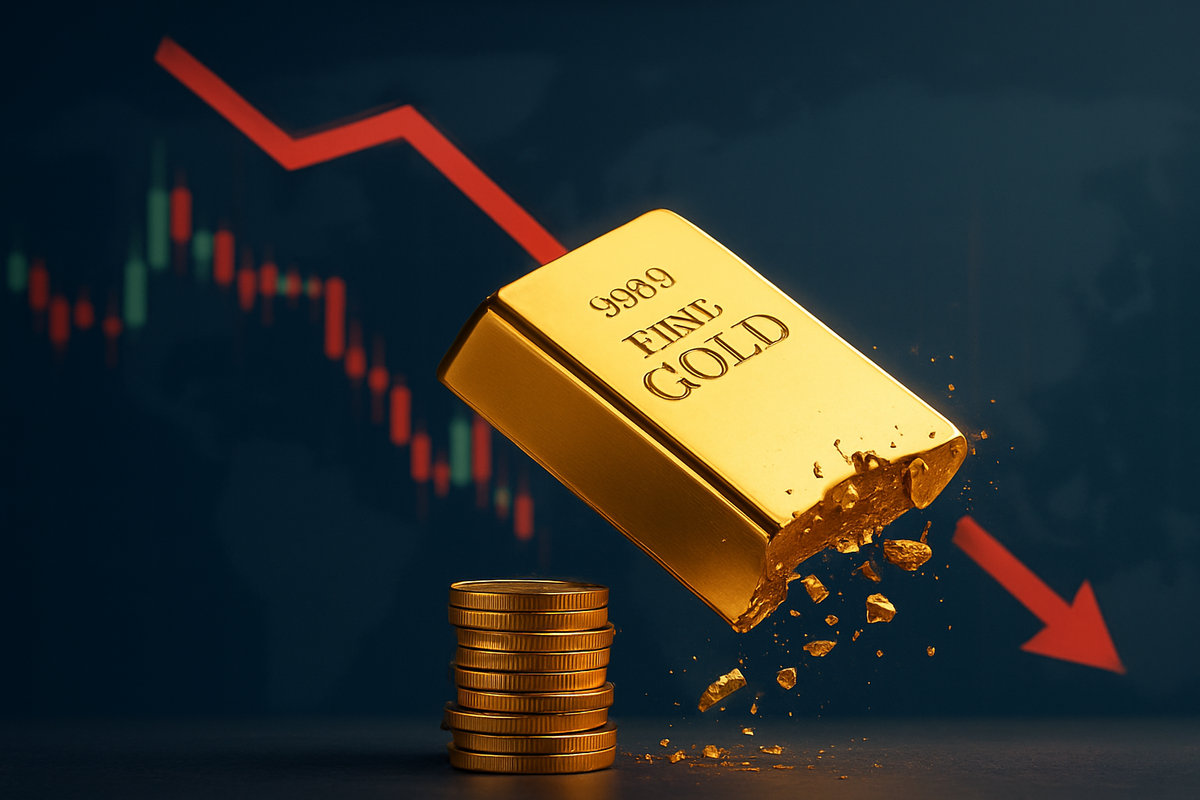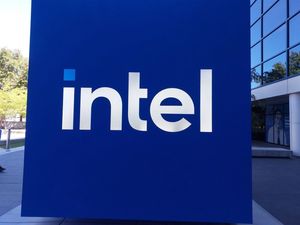
The precious metal market is currently experiencing a significant tremor as gold prices have plummeted, breaching the psychologically important $4,000 per ounce mark in October 2025. This sharp decline, with spot gold trading around $3,963.53 per ounce as of October 28, 2025, represents a substantial correction from its earlier record high of $4,381.58 achieved within the same month. The rapid descent, described by some as the steepest drop in 12 years and a more than 10% fall within a single week, has sent ripples across financial markets and forced investors to re-evaluate their positions.
This dramatic downturn in gold's valuation is primarily driven by a confluence of factors, including a pronounced shift in investor sentiment from safe-haven assets towards riskier equities, significant profit-taking after a robust rally, and technical selling pressure triggered by the breach of key support levels. While short-term market sentiment leans bearish, major financial institutions like JPMorgan (NYSE: JPM) and Goldman Sachs (NYSE: GS) are framing this correction as a "healthy consolidation phase" and a potential buying opportunity for long-term investors, suggesting that gold's fundamental drivers may still hold sway in the broader economic landscape.
The Swift Descent: A Timeline of Gold's Recent Volatility
The recent fall of gold prices below $4,000 an ounce marks a pivotal moment in the precious metals market, following a period of unprecedented gains. Earlier in October 2025, gold had soared to an all-time high of $4,381.58 per ounce, fueled by persistent geopolitical uncertainties, inflation concerns, and robust central bank demand. This rally had seen gold's value appreciate by nearly 50% year-to-date, attracting a wide array of investors seeking refuge from global economic volatility. However, the momentum began to shift rapidly as optimism surrounding global trade negotiations started to emerge.
The primary catalyst for gold's sharp reversal was the unexpected progress in US-China trade talks. Reports surfaced in mid-October indicating that officials from both nations had reached a framework agreement on tariffs and other contentious issues during weekend discussions in Malaysia. This de-escalation of trade tensions immediately dampened the appeal of safe-haven assets like gold, prompting a swift rotation into riskier, growth-oriented assets. The market's "risk-on" appetite was further bolstered by expectations of a 25-basis-point interest rate cut by the Federal Reserve (NYSE: FRB) following softer-than-expected inflation data, though this factor was largely overshadowed by the trade optimism.
Key players and stakeholders involved in this market movement include large institutional investors, hedge funds, and retail traders who had accumulated significant long positions in gold. The initial market reaction was characterized by widespread profit-taking, as investors capitalized on gold's substantial gains. This led to significant outflows from gold exchange-traded funds (ETFs), with some reporting the largest single-day outflows since May, further exacerbating the downward pressure. Technical analysts also noted that the breach of the $4,000 psychological barrier triggered automated selling orders, accelerating the price decline and confirming a bearish short-term trend.
Navigating the Volatility: Winners and Losers in the Gold Market Shift
The dramatic decline in gold prices below $4,000 per ounce is creating a distinct bifurcation in the financial landscape, producing clear winners and losers across various sectors. For gold mining companies, the immediate impact is largely negative. Companies like Barrick Gold (NYSE: GOLD), Newmont (NYSE: NEM), and AngloGold Ashanti (NYSE: AU) will likely see pressure on their profit margins as the revenue generated from gold sales decreases. While many miners have hedged their production, a sustained lower price environment could force a re-evaluation of high-cost operations and future exploration projects. Their stock prices are expected to reflect this downturn, potentially leading to investor apprehension and a reallocation of capital away from the sector.
Conversely, sectors that benefit from a "risk-on" environment stand to gain. Equity markets, particularly those tied to global growth and trade, are experiencing a boost. Technology companies, industrial giants, and consumer discretionary firms are attracting capital as investors seek higher returns outside of safe havens. Financial institutions, including major banks like JPMorgan (NYSE: JPM) and Bank of America (NYSE: BAC), could also see increased activity in their investment banking and trading divisions as capital flows shift and market volatility creates new opportunities for arbitrage and structured products. Jewelers and manufacturers that use gold as a raw material, such as Tiffany & Co. (NYSE: TIF) or Signet Jewelers (NYSE: SIG), might experience a temporary benefit from lower input costs, potentially boosting their margins if consumer demand remains stable or improves.
Furthermore, investors who had hedged against a gold downturn or held short positions are now reaping significant profits. Futures traders and options investors who correctly anticipated the correction are seeing substantial gains. For long-term investors who believe in gold's fundamental value, the current dip is being viewed as a strategic buying opportunity. Major investment banks are advising clients that this "healthy consolidation" presents an attractive entry point for accumulation, anticipating a rebound in prices in the medium to long term driven by underlying economic and geopolitical factors. However, those who entered the market at gold's recent peak are facing significant paper losses, underscoring the inherent risks of speculative investing in volatile commodities.
Broader Implications: Gold's Fall and the Shifting Global Economy
The precipitous fall of gold prices below $4,000 per ounce is more than just a commodity market event; it is a significant indicator of broader shifts within the global financial landscape. This event fits squarely into a trend of increasing investor confidence in global economic stability and growth, largely spurred by de-escalating trade tensions. For much of 2025, gold's rally was underpinned by anxieties surrounding trade wars, geopolitical conflicts, and inflationary pressures. The recent breakthrough in US-China trade negotiations has fundamentally altered this narrative, reducing the perceived need for safe-haven assets and encouraging a rotation into riskier, growth-oriented investments. This pivot suggests a market that is increasingly optimistic about a more stable and predictable international trade environment.
The ripple effects of this shift extend far beyond the immediate gold market. Competitors to gold, primarily other safe-haven assets like government bonds, may also see reduced demand if the "risk-on" sentiment persists. Conversely, equity markets globally are likely to continue their ascent, benefiting from increased capital inflows. Emerging markets, often more sensitive to global trade dynamics, could experience renewed investor interest. Partners in the global supply chain, particularly those reliant on international trade, may see improved prospects, leading to a potential boost in manufacturing and logistical sectors. Regulatory bodies will be closely monitoring market stability, though direct policy implications from this specific gold price movement are likely minimal, as it reflects market forces rather than systemic failures.
Historically, sharp corrections in gold prices often follow periods of rapid ascent, acting as a natural rebalancing mechanism. Similar events have occurred during periods of improving economic outlooks or significant geopolitical de-escalation. For instance, in times when global growth prospects brightened or major crises abated, gold has historically relinquished some of its safe-haven premium. This current decline can be compared to corrections seen after previous gold rallies, where the market consolidates before potentially finding a new equilibrium. The key difference this time is the magnitude of the preceding rally and the specific catalyst of major trade deal progress, which signals a potentially more sustained shift in investor psychology away from fear-driven asset allocation.
What Comes Next: Navigating Gold's Future Landscape
The immediate future for gold prices remains a subject of intense debate, with both short-term challenges and long-term opportunities on the horizon. In the short term, continued "risk-on" sentiment driven by further positive developments in global trade talks could exert additional downward pressure on gold. Technical selling, especially if key support levels are breached, may also contribute to further declines. Traders will be closely watching for signs of stabilization or a bounce, particularly around significant technical levels. However, many analysts believe that the bulk of the correction may have already occurred, and the market could enter a consolidation phase.
Looking further ahead, the long-term outlook for gold remains robust according to several major financial institutions. JPMorgan (NYSE: JPM), for instance, forecasts gold hitting $5,055 by late 2026 and potentially $8,000 by 2028, while Goldman Sachs (NYSE: GS) maintains a $4,900 end-2026 target. These projections are predicated on underlying factors such as continued central bank buying, anticipated Federal Reserve (NYSE: FRB) interest rate cuts, ongoing economic and geopolitical uncertainties that could resurface, and persistent concerns over currency debasement. Should these fundamental drivers regain prominence, gold could experience another significant rally.
Potential strategic pivots or adaptations will be required for various market participants. Gold miners may need to re-evaluate their operational efficiencies and investment strategies to remain profitable in a lower price environment. Investors might consider diversifying their portfolios to include a balance of growth assets and strategically timed gold allocations. Market opportunities could emerge for those willing to buy the dip, particularly if they believe in gold's long-term store of value. Conversely, challenges will arise for those heavily exposed to gold without sufficient hedging, facing sustained losses. Potential scenarios range from a rapid rebound if trade talks falter or new geopolitical risks emerge, to a prolonged period of consolidation before a gradual recovery. The outcomes will largely depend on the evolving global economic and political landscape.
Gold's New Chapter: A Market Reassessment
The recent plunge of gold prices below $4,000 per ounce marks a pivotal moment, signaling a significant reassessment of market dynamics and investor sentiment. The key takeaway from this event is the powerful impact of de-escalating global trade tensions on safe-haven assets. After a spectacular rally fueled by uncertainty, gold's sharp correction underscores a shift towards a "risk-on" environment, with capital flowing out of defensive positions and into growth-oriented equities. This move, while painful for some, is viewed by many institutional players as a necessary and "healthy consolidation" that rebalances the market after an extended period of upward trajectory.
Moving forward, the market will be characterized by a fascinating interplay between short-term bearish pressures and long-term bullish fundamentals. While the immediate future may see continued volatility and potential for further technical selling, the underlying drivers that historically support gold – central bank demand, geopolitical risks, and currency concerns – are not expected to disappear entirely. Investors should assess their portfolios, considering whether their exposure to gold aligns with their long-term objectives and risk tolerance in this evolving landscape.
The lasting impact of this event will likely be a more nuanced understanding of gold's role in a diversified portfolio. It reinforces the notion that even safe-haven assets are not immune to significant corrections, especially when the catalysts that drove their appreciation begin to wane. Investors should watch closely for further developments in global trade negotiations, monetary policy signals from central banks, and any resurgence of geopolitical tensions, as these factors will be crucial in dictating gold's trajectory in the coming months. This period represents a new chapter for gold, where its value will be tested against a backdrop of shifting global optimism and persistent underlying uncertainties.
This content is intended for informational purposes only and is not financial advice





